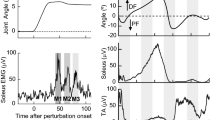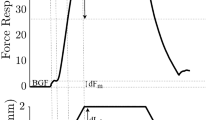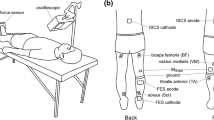Abstract
The size of the soleus H-reflex was measured after a slow (17 deg/s) passive stretch of ankle plantarflex ors and compared to its control size without muscle stretch in ten neurologically healthy subjects and in six spastic spinal-cord-injured patients. Two seconds after the end of the stretch, the size of the H-reflex was reduced to about 30% of its pre-stretch size in the healthy sub jects. The depression remained for 10–15 s. In the spastic, spinal-cord-injured patients, stretch caused significantly less reduction in the size of the H-reflex. The H-reflex also regained its pre-stretch size much faster than in healthy subjects. We suggest that the smaller depression of the H-reflex observed in spastic patients may be involved in the pathophysiology of spasticity.
Similar content being viewed by others
References
Ashby P, Verrier M, Carleton S (1980) Vibratory inhibition of the monosynaptic reflex. Prog Clin Neurophysiol 8:254–262
Ballegaard M, Hultborn H, Illert M, Nielsen J, Paul A, Wiese H (1991) Slow passive stretches of a muscle depresses transmission of its monosynaptic reflex. Eur J Neurosci [Suppl 4]: 298
Crone C, Nielsen J (1989) Methodological implications of the post activation depression of the soleus H-reflex in man. Exp Brain Res 78:28–32
Curtis DR, Eccles JC (1960) Synaptic action during and after repetitive stimulation. J Physiol (London) 150:374–398
Delwaide PJ (1973) Human monosynaptic reflexes and presynaptic inhibition. In: Desmedt JE (ed) New developments in electromyography and clinical neurophysiology, vol 3. Karger, Basel, pp 486–507
Gerilovsky L, Tsvetinov P, Trenkova G (1989) Peripheral effects on the amplitude of monopolar and bipolar H-reflex potentials from the soleus muscle. Exp Brain Res 76:173–181
Hoffmann P (1918) Über die Beziehungen der Sehnenreflexe zur willkürlichen Bewegung. Z Biol 68:351–370
Hultborn H, Meunier S, Morin C, Pierrot-Deseilligny E (1987) Assessing changes in presynaptic inhibition of Ia fibres: a study in man and the cat. J Physiol (Lond) 389:729–756
Katz R, Morin C, Pierrot-Deseilligny E, Hibino R (1977) Conditioning of H reflex by a preceding subthreshold tendon reflex stimulus. J Neurol Neurosurg Psychiatry 40:575–580
Lance JW (1980) Symposium synopsis. In: Feldman RG, Young RR, Koella WP (eds) Spasticity: disordered motor control. Year book, Chicago London, pp 485–494
Noth J (1991) Trends in the pathophysiology and pharmacotherapy of spasticity. J Neurol 238:131–139
Pierrot-Deseilligny E, Mazieres L (1985) Spinal mechanisms underlying spasticity. In: Delwaide PJ, Young RR (eds) Clinical neurophysiology in spasticity. Elsevier, Amsterdam New York, pp 63–76
Schmidt RF (1971) Presynaptic inhibition in the vertebrate central nervous system. Ergebn Physiol 63:20–101
Author information
Authors and Affiliations
Rights and permissions
About this article
Cite this article
Nielsen, J., Petersen, N., Ballegaard, M. et al. H-reflexes are less depressed following muscle stretch in spastic spinal cord injured patients than in healthy subjects. Exp Brain Res 97, 173–176 (1993). https://doi.org/10.1007/BF00228827
Received:
Accepted:
Issue Date:
DOI: https://doi.org/10.1007/BF00228827




